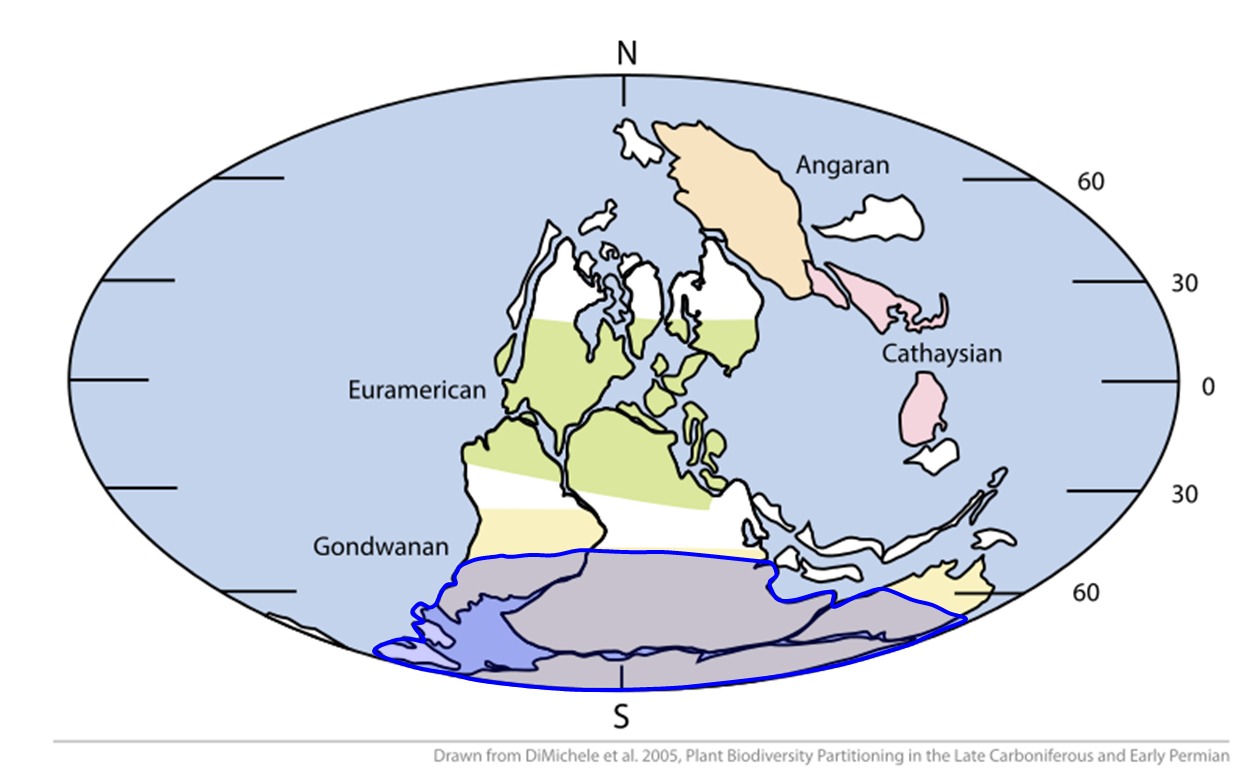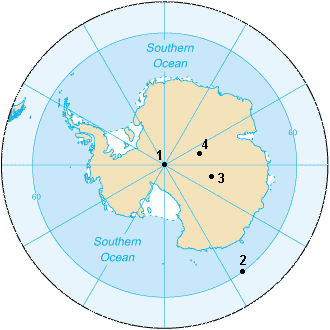|
Karoo Glaciation
The late Paleozoic icehouse, also known as the Late Paleozoic Ice Age (LPIA) and formerly known as the Karoo ice age, was an ice age that began in the Late Devonian and ended in the Late Permian, occurring from 360 to 255 million years ago (Mya), and large land-based ice sheets were then present on Earth's surface."The late Paleozoic icehouse was the longest-lived ice age of the Phanerozoic, and its demise constitutes the only recorded turnover to a greenhouse state." It was the second major icehouse period of the Phanerozoic, after the Late Ordovician Andean-Saharan glaciation. Timeline Interpretations of the LPIA vary, with some researchers arguing it represented one continuous glacial event and others concluding that as many as twenty-five separate ice sheets across Gondwana developed, waxed, and waned independently and diachronously over the course of the Carboniferous and Permian, with the distribution of ice centres shifting as Gondwana drifted and its position relative ... [...More Info...] [...Related Items...] OR: [Wikipedia] [Google] [Baidu] |
South Pole
The South Pole, also known as the Geographic South Pole or Terrestrial South Pole, is the point in the Southern Hemisphere where the Earth's rotation, Earth's axis of rotation meets its surface. It is called the True South Pole to distinguish from the south magnetic pole. The South Pole is by definition the southernmost point on the Earth, lying antipode (geography), antipodally to the North Pole. It defines geodetic latitude 90° South, as well as the direction of true south. At the South Pole all directions point North; all lines of longitude converge there, so its longitude can be defined as any degree value. No time zone has been assigned to the South Pole, so any time can be used as the local time. Along tight latitude circles, clockwise is east and counterclockwise is west. The South Pole is at the center of the Southern Hemisphere. Situated on the continent of Antarctica, it is the site of the United States Amundsen–Scott South Pole Station, which was established in 19 ... [...More Info...] [...Related Items...] OR: [Wikipedia] [Google] [Baidu] |
Proceedings Of The National Academy Of Sciences Of The United States Of America
''Proceedings of the National Academy of Sciences of the United States of America'' (often abbreviated ''PNAS'' or ''PNAS USA'') is a peer-reviewed multidisciplinary scientific journal. It is the official journal of the National Academy of Sciences, published since 1915, and publishes original research, scientific reviews, commentaries, and letters. According to ''Journal Citation Reports'', the journal has a 2022 impact factor of 9.4. ''PNAS'' is the second most cited scientific journal, with more than 1.9 million cumulative citations from 2008 to 2018. In the past, ''PNAS'' has been described variously as "prestigious", "sedate", "renowned" and "high impact". ''PNAS'' is a delayed open-access journal, with an embargo period of six months that can be bypassed for an author fee ( hybrid open access). Since September 2017, open access articles are published under a Creative Commons license. Since January 2019, ''PNAS'' has been online-only, although print issues are available ... [...More Info...] [...Related Items...] OR: [Wikipedia] [Google] [Baidu] |
Global And Planetary Change
''Global and Planetary Change'' is a monthly peer-reviewed scientific journal covering research into the earth sciences, particularly pertaining to changes in aspects thereof such as sea level and the chemical composition of the atmosphere. It has been published by Elsevier since it was established in 1989. The editors-in-chief are Alan Haywood, Jed Kaplan, Trude Storelvmo, Liviu Matenco, Zhengtang Guo, Maoyan Zhu, Fabienne Marret-Davies, Howard Falcon-Lang. According to the ''Journal Citation Reports'', the journal has a 2021 impact factor The impact factor (IF) or journal impact factor (JIF) of an academic journal is a type of journal ranking. Journals with higher impact factor values are considered more prestigious or important within their field. The Impact Factor of a journa ... of 5.114. References External links * Earth and atmospheric sciences journals Planetary science journals Academic journals established in 1989 Elsevier academic journals Monthly jour ... [...More Info...] [...Related Items...] OR: [Wikipedia] [Google] [Baidu] |
Bashkirian
The Bashkirian is in the International Commission on Stratigraphy geologic timescale the lowest stage (stratigraphy), stage or oldest age (geology), age of the Pennsylvanian (geology), Pennsylvanian. The Bashkirian age lasted from to Mega annum, Ma, is preceded by the Serpukhovian and is followed by the Moscovian (Carboniferous), Moscovian. The Bashkirian overlaps with the upper part of the Namurian and lower part of the Westphalian (stage), Westphalian stages from regional European stratigraphy. It also overlaps with the North American Morrowan and Atokan stages and the Chinese Luosuan and lower Huashibanian stages. Name and definition The Bashkirian was named after Bashkiria, the then Russian name of the republic of Bashkortostan in the southern Ural Mountains of Russia, home of the Bashkir people. The stage was introduced by Russian stratigrapher Sofia Viktorovna Semikhartova, Sofia Semikhatova in 1934. The base of the Bashkirian is at the first appearance of conodont spec ... [...More Info...] [...Related Items...] OR: [Wikipedia] [Google] [Baidu] |
Moscovian (Carboniferous)
The Moscovian is in the International Commission on Stratigraphy, ICS geologic timescale a stage (stratigraphy), stage or age (geology), age in the Pennsylvanian (geology), Pennsylvanian, the youngest system (stratigraphy), subsystem of the Carboniferous. The Moscovian age lasted from to Megaannum, Ma, is preceded by the Bashkirian and is followed by the Kasimovian. The Moscovian overlaps with the European regional Westphalian (stage), Westphalian stage and the North American Atokan and Desmoinesian stages. Name and definition The Moscovian Stage was introduced by Sergei Nikitin (geologist), Sergei Nikitin (1850 - 1909) in 1890, using brachiopods in the Moscow Basin of European Russia. Nikitin named the stage after Moscow, then a major city and now the capital of Russia. The base of the Moscovian is close to the first appearances of the conodonts ''Declinognathodus donetzianus'' and ''Idiognathoides postsulcatus'' or otherwise the fusulinid ''Aljutovella aljutovica''. Because t ... [...More Info...] [...Related Items...] OR: [Wikipedia] [Google] [Baidu] |
Glacial Period
A glacial period (alternatively glacial or glaciation) is an interval of time (thousands of years) within an ice age that is marked by colder temperatures and glacier advances. Interglacials, on the other hand, are periods of warmer climate between glacial periods. The Last Glacial Period ended about 15,000 years ago. The Holocene is the current interglacial. A time with no glaciers on Earth is considered a Greenhouse and icehouse Earth, greenhouse climate state. Quaternary Period Within the Quaternary, which started about 2.6 million years before present, there have been a number of glacials and interglacials. At least eight glacial cycles have occurred in the last 740,000 years alone. Changes in atmospheric and associated radiative forcing were among the primary drivers of globally cold glacial and warm interglacial climates, with changes in ocean physical circulation, biological productivity and seawater acid-base chemistry likely causing most of the recorded changes Penul ... [...More Info...] [...Related Items...] OR: [Wikipedia] [Google] [Baidu] |
Serpukhovian
The Serpukhovian is in the ICS geologic timescale the uppermost stage or youngest age of the Mississippian, the lower subsystem of the Carboniferous. The Serpukhovian age lasted from Ma to Ma. It is preceded by the Visean and is followed by the Bashkirian. The Serpukhovian correlates with the lower part of the Namurian Stage of European stratigraphy and the middle and upper parts of the Chesterian Stage of North American stratigraphy. Name and definition The Serpukhovian Stage was proposed in 1890 by Russian stratigrapher Sergei Nikitin and was introduced in the official stratigraphy of European Russia in 1974. It was named after the city of Serpukhov, near Moscow. The ICS later used the upper Russian subdivisions of the Carboniferous in its international geologic time scale. The base of the Serpukhovian is informally defined by the first appearance of the conodont '' Lochriea ziegleri'', though the utility and systematic stability of this species is not yet certain. ... [...More Info...] [...Related Items...] OR: [Wikipedia] [Google] [Baidu] |
Viséan
The Visean, Viséan or Visian is an age in the ICS geologic timescale or a stage in the stratigraphic column. It is the second stage of the Mississippian, the lower subsystem of the Carboniferous. The Visean lasted from to Ma. It follows the Tournaisian age/stage and is followed by the Serpukhovian age/stage. Name and definitions The Viséan Stage was introduced by Belgian geologist André Dumont in 1832. Dumont named this stage after the city of Visé in Belgium's Liège Province. Before being used as an international stage, the Viséan Stage was part of the (West) European regional geologic time scale, in which it followed the Tournaisian Stage and is followed by the Namurian Stage. In the North American regional scale, the Viséan Stage correlates with the upper Osagean, the Meramecian and lower Chesterian stages. In the Chinese regional time scale, it correlates with the lower and middle Tatangian series.; 2006: ''Global time scale and regional stratigraphic ... [...More Info...] [...Related Items...] OR: [Wikipedia] [Google] [Baidu] |
Transient State
In systems theory, a system is said to be transient or in a transient state when a process variable or variables have been changed and the system has not yet reached a steady state. In electrical engineering, the time taken for an electronic circuit to change from one steady state to another steady state is called the transient time. Examples Chemical Engineering When a chemical reactor is being brought into operation, the concentrations, temperatures, species compositions, and reaction rates are changing with time until operation reaches its nominal process variables. Electrical engineering When a switch is closed in an electrical circuit containing a capacitor or inductor, the component draws out the resulting change in voltage or current, causing the system to take a substantial amount of time to reach a new steady state. This period of time is known as the transient state. A capacitor acts as a short circuit immediately after the switch is closed, increasing its impedanc ... [...More Info...] [...Related Items...] OR: [Wikipedia] [Google] [Baidu] |
δ15N
In geochemistry, hydrology, paleoclimatology and paleoceanography, ''δ''15N (pronounced "delta fifteen n") or delta-N-15 is a measure of the ratio of the two stable isotopes of nitrogen, 15N: 14N. Formulas Two very similar expressions for are in wide use in hydrology. Both have the form 1000\cdot\fraca ‰ (‰ = permil or parts per thousand) where ''s'' and ''a'' are the relative abundances of 15N in respectively the sample and the atmosphere. The difference is whether the relative abundance is with respect to all the nitrogen, i.e. 14N plus 15N, or just to 14N. Since the atmosphere is 99.6337% 14N and 0.3663% 15N, ''a'' is 0.003663 in the former case and 0.003663/0.996337 = 0.003676 in the latter. However ''s'' varies similarly; for example if in the sample 15N is 0.385% and 14N is 99.615%, ''s'' is 0.003850 in the former case and 0.00385/0.99615 = 0.003865 in the latter. The value of 1000\cdot\fraca is then 51.05‰ in the former case and 51.38‰ in the latter, an in ... [...More Info...] [...Related Items...] OR: [Wikipedia] [Google] [Baidu] |
Journal Of The Geological Society
The ''Journal of the Geological Society '' is a peer-reviewed scientific journal published by the Geological Society of London. It covers research in all aspects of the Earth sciences. References External links * Proceedings of the Geological Society of London Vol 1 (1826–1833) to Vol 4 (1843–1845) available online at the Biodiversity Heritage Library The Biodiversity Heritage Library (BHL) is the world’s largest open-access digital library for biodiversity literature and archives. BHL operates as a worldwide consortium of natural history, botanical, research, and national libraries working ...The Quarterly journal of the Geological Society of London Vol 1 (1845) to Vol 72 (1923) available online at the Biodiversity Heritage Library Publications established in 1826 Geology journals Bimonthly journals Geological Society of London academic journals English-language journals Academic journals published by learned and professional societies 1826 establishments ... [...More Info...] [...Related Items...] OR: [Wikipedia] [Google] [Baidu] |


